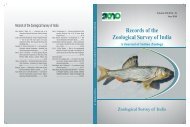Andaman booklet aw.FH10 - Zoological Survey of India
Andaman booklet aw.FH10 - Zoological Survey of India
Andaman booklet aw.FH10 - Zoological Survey of India
Create successful ePaper yourself
Turn your PDF publications into a flip-book with our unique Google optimized e-Paper software.
<strong>Andaman</strong> teal, and several endemic amphibians that are habitat<br />
specialists.<br />
The least disturbed and the best preserved, mangroves in <strong>India</strong> can<br />
be found on the <strong>Andaman</strong> and Nicobar Islands. Along with the<br />
inland forests, the mangroves are the predominant terrestrial<br />
ecosystem <strong>of</strong> the islands. Their value in conserving soil and protecting<br />
creeks and harbours from siltation and erosion cannot be overemphasised,<br />
particularly in the small islands. These mangroves<br />
support a rich diversity <strong>of</strong> fauna and in particular provide breeding<br />
and sp<strong>aw</strong>ning habitats for many aquatic species (Rao and Khan,<br />
1990) and to the saltwater crocodile and several species <strong>of</strong> birds<br />
and reptiles.<br />
Grasslands, on the other hand, are an unusual feature found only in<br />
a few islands <strong>of</strong> the Nicobar group. They occur as patches on low<br />
hillsides, surrounded by good forest growth, on the islands <strong>of</strong><br />
Bompoka, Teressa, Katchall and Camorta.<br />
The <strong>Andaman</strong> and Nicobar Islands have a significant marine<br />
ecosystem. Although the land area is only 8,249 km 2 , the exclusive<br />
economic zone (EEZ) <strong>of</strong> the islands extending to 200 nautical miles<br />
from the shoreline is 75 times larger, approximately 6 lakh (0.6<br />
05
















